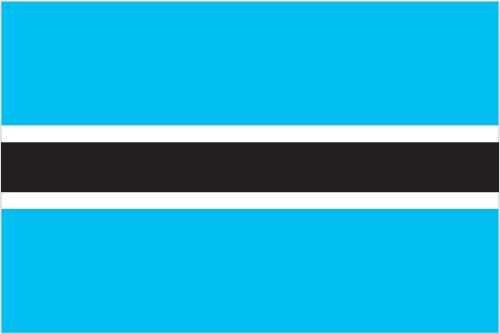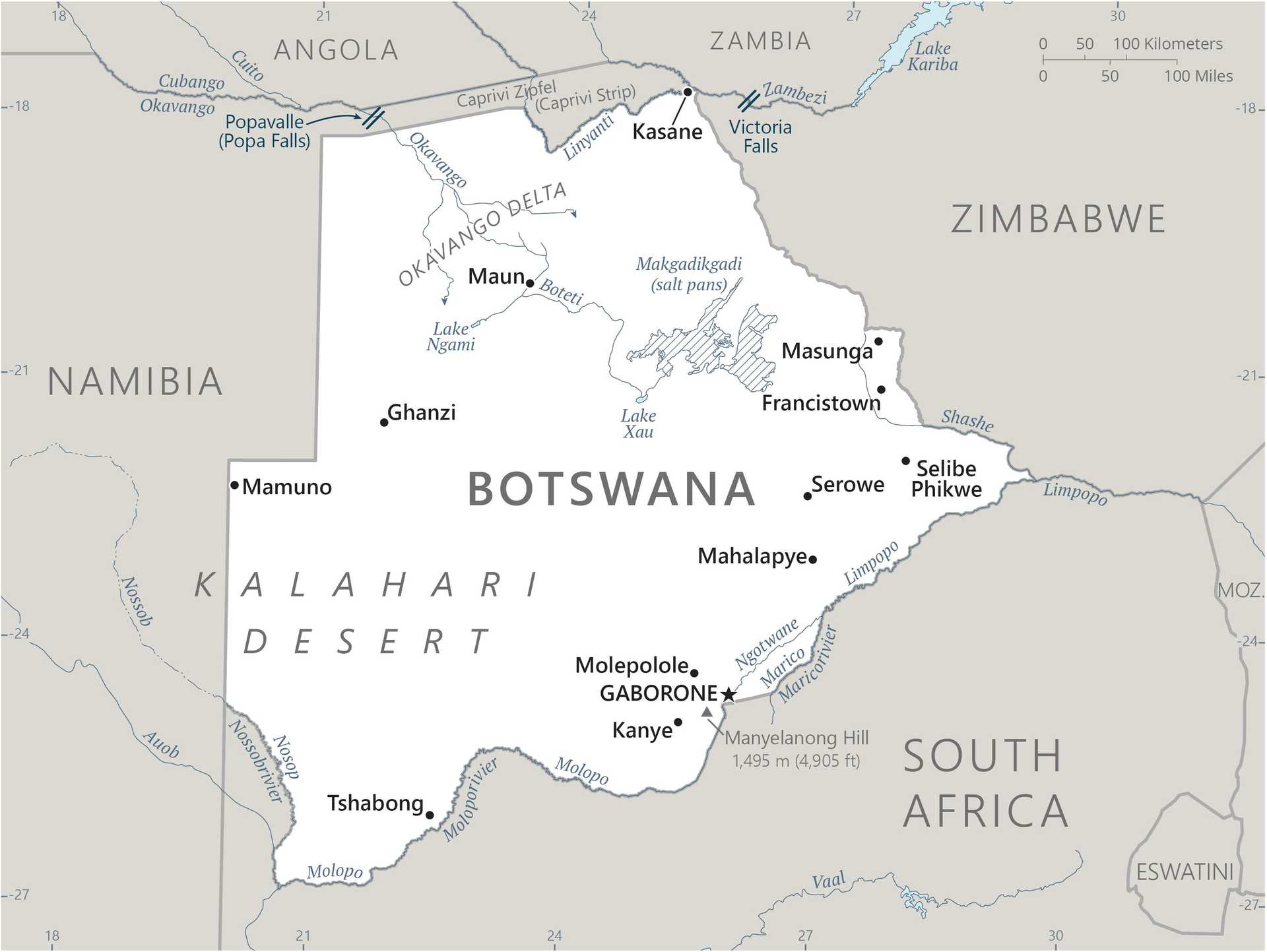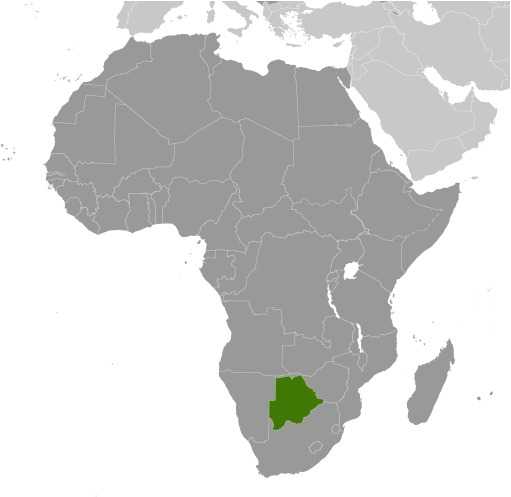Introduction
Background
In the early 1800s, multiple political entities in what is now Botswana were destabilized or destroyed by a series of conflicts and population movements in southern Africa. By the end of this period, the Tswana ethnic group, who also live across the border in South Africa, had become the most prominent group in the area. In 1852, Tswana forces halted the expansion of white Afrikaner settlers who were seeking to expand their territory northwards into what is now Botswana. In 1885, Great Britain claimed territory that roughly corresponds with modern day Botswana as a protectorate called Bechuanaland. Upon independence in 1966, the British protectorate of Bechuanaland adopted the new name of Botswana, which means "land of the Tswana."
More than five decades of uninterrupted civilian leadership, progressive social policies, and significant capital investment have created an enduring democracy and upper-middle-income economy. The ruling Botswana Democratic Party has won every national election since independence; President Mokgweetsi Eric Keabetswe MASISI assumed the presidency in 2018 after the retirement of former President Ian KHAMA due to constitutional term limits. MASISI won his first election as president in 2019, and he is Botswana’s fifth president since independence. Mineral extraction, principally diamond mining, dominates economic activity, though tourism is a growing sector due to the country's conservation practices and extensive nature preserves. Botswana has one of the world's highest rates of HIV/AIDS infection but also one of Africa's most progressive and comprehensive programs for dealing with the disease.
Visit the Definitions and Notes page to view a description of each topic.
Geography
Location
Southern Africa, north of South Africa
Geographic coordinates
22 00 S, 24 00 E
Map references
Africa
Area - comparative
slightly smaller than Texas; almost four times the size of Illinois
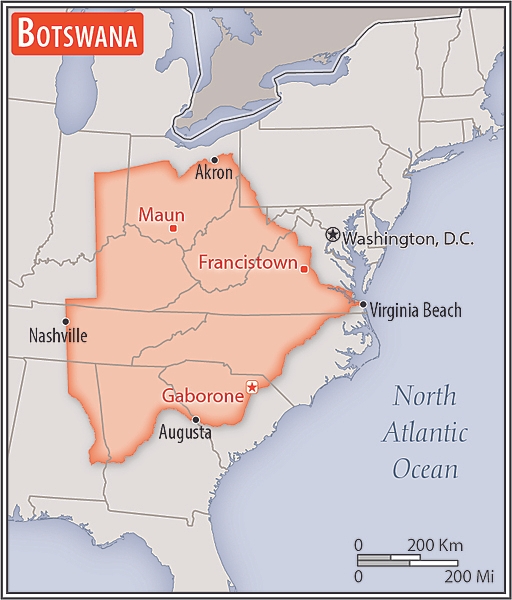
Land boundaries
total: 4,347.15 km
border countries (4): Namibia 1,544 km; South Africa 1,969 km; Zambia 0.15 km; Zimbabwe 834 km
Coastline
0 km (landlocked)
Maritime claims
none (landlocked)
Climate
semiarid; warm winters and hot summers
Terrain
predominantly flat to gently rolling tableland; Kalahari Desert in southwest
Elevation
highest point: Manyelanong Hill 1,495 m
lowest point: junction of the Limpopo and Shashe Rivers 513 m
mean elevation: 1,013 m
Natural resources
diamonds, copper, nickel, salt, soda ash, potash, coal, iron ore, silver
Land use
agricultural land: 45.8% (2018 est.)
arable land: 0.6% (2018 est.)
permanent crops: 0% (2018 est.)
permanent pasture: 45.2% (2018 est.)
forest: 19.8% (2018 est.)
other: 34.4% (2018 est.)
Irrigated land
25 sq km (2014)
Major rivers (by length in km)
Zambezi (shared with Zambia [s]), Angola, Namibia, Zimbabwe, and Mozambique [m]) - 2,740 km; Limpopo (shared with South Africa [s], Zimbabwe, and Mozambique [m]) - 1,800 km; Okavango river mouth (shared with Angola [s], and Namibia) - 1,600 km
note – [s] after country name indicates river source; [m] after country name indicates river mouth
Major watersheds (area sq km)
Atlantic Ocean drainage: Orange (941,351 sq km)
Indian Ocean drainage: Zambezi (1,332,412 sq km)
Internal (endorheic basin) drainage: Okavango Basin (863,866 sq km)
Major aquifers
Lower Kalahari-Stampriet Basin, Upper Kalahari-Cuvelai-Upper Zambezi Basin
Population distribution
the population is primarily concentrated in the east with a focus in and around the captial of Gaborone, and the far central-eastern city of Francistown; population density remains low in other areas in the country, especially in the Kalahari to the west as shown in this population distribution map
Natural hazards
periodic droughts; seasonal August winds blow from the west, carrying sand and dust across the country, which can obscure visibility
Geography - note
landlocked; sparsely populated with most settlement concentrated in the southern and eastern parts of the country; geography dominated by the Kalahari Desert, which covers about 70% of the country, although the Okavango Delta brings considerable biodiversity as one of the largest inland deltas in the World
People and Society
Population
total: 2,450,668
male: 1,174,306
female: 1,276,362 (2024 est.)
comparison rankings: female 143; male 146; total 146
Nationality
noun: Motswana (singular), Batswana (plural)
adjective: Motswana (singular), Batswana (plural)
Ethnic groups
Tswana (or Setswana) 79%, Kalanga 11%, Basarwa 3%, other, including Kgalagadi and people of European ancestry 7%
Languages
Setswana 77.3%, Sekalanga 7.4%, Shekgalagadi 3.4%, English (official) 2.8%, Zezuru/Shona 2%, Sesarwa 1.7%, Sembukushu 1.6%, Ndebele 1%, other 2.8% (2011 est.)
Religions
Christian 79.1%, Badimo 4.1%, other 1.4% (includes Baha'i, Hindu, Muslim, Rastafarian), none 15.2%, unspecified 0.3% (2011 est.)
Demographic profile
Botswana has experienced one of the most rapid declines in fertility in Sub-Saharan Africa. The total fertility rate fell from more than 5 children per woman in the mid 1980s to approximately 2.4 in 2013, and remains at that level in 2022. The fertility reduction has been attributed to a host of factors, including higher educational attainment among women, greater participation of women in the workforce, increased contraceptive use, later first births, and a strong national family planning program. Botswana was making significant progress in several health indicators, including life expectancy and infant and child mortality rates, until being devastated by the HIV/AIDs epidemic in the 1990s.
In 2021, Botswana had one of the highest HIV/AIDS prevalence rates in the world at close to 20%, however comprehensive and effective treatment programs have reduced HIV/AIDS-related deaths. The combination of declining fertility and increasing mortality rates because of HIV/AIDS is slowing the population aging process, with a narrowing of the youngest age groups and little expansion of the oldest age groups. Nevertheless, having the bulk of its population (about 60% as of 2022) of working age will only yield economic benefits if the labor force is healthy, educated, and productively employed.
Batswana have been working as contract miners in South Africa since the 19th century. Although Botswana’s economy improved shortly after independence in 1966 with the discovery of diamonds and other minerals, its lingering high poverty rate and lack of job opportunities continued to push workers to seek mining work in southern African countries. In the early 1970s, about a third of Botswana’s male labor force worked in South Africa (lesser numbers went to Namibia and Zimbabwe). Not until the 1980s and 1990s, when South African mining companies had reduced their recruitment of foreign workers and Botswana’s economic prospects had improved, were Batswana increasingly able to find job opportunities at home.
Most Batswana prefer life in their home country and choose cross-border migration on a temporary basis only for work, shopping, visiting family, or tourism. Since the 1970s, Botswana has pursued an open migration policy enabling it to recruit thousands of foreign workers to fill skilled labor shortages. In the late 1990s, Botswana’s prosperity and political stability attracted not only skilled workers but small numbers of refugees from neighboring Angola, Namibia, and Zimbabwe.
Age structure
0-14 years: 28.7% (male 355,583/female 348,863)
15-64 years: 65.2% (male 759,210/female 837,752)
65 years and over: 6.1% (2024 est.) (male 59,513/female 89,747)
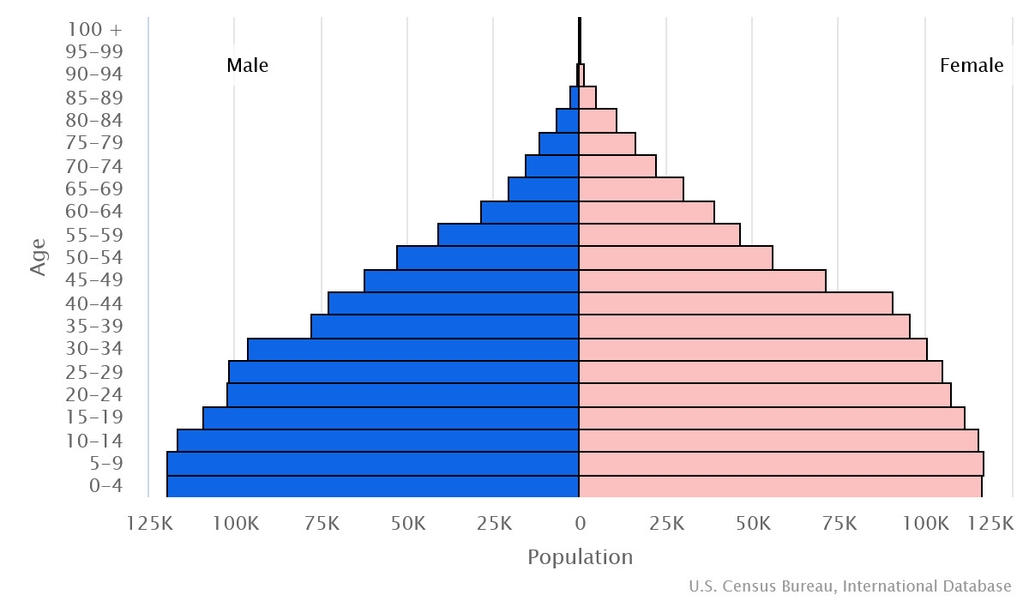
Dependency ratios
total dependency ratio: 57.5
youth dependency ratio: 51.8
elderly dependency ratio: 5.7
potential support ratio: 13.8 (2021 est.)
Median age
total: 27.1 years (2024 est.)
male: 26 years
female: 28.3 years
comparison ranking: total 161
Population distribution
the population is primarily concentrated in the east with a focus in and around the captial of Gaborone, and the far central-eastern city of Francistown; population density remains low in other areas in the country, especially in the Kalahari to the west as shown in this population distribution map
Urbanization
urban population: 72.9% of total population (2023)
rate of urbanization: 2.47% annual rate of change (2020-25 est.)
Major urban areas - population
269,000 GABORONE (capital) (2018)
Sex ratio
at birth: 1.03 male(s)/female
0-14 years: 1.02 male(s)/female
15-64 years: 0.91 male(s)/female
65 years and over: 0.66 male(s)/female
total population: 0.92 male(s)/female (2024 est.)
Infant mortality rate
total: 23.7 deaths/1,000 live births (2024 est.)
male: 25.9 deaths/1,000 live births
female: 21.4 deaths/1,000 live births
comparison ranking: total 65
Life expectancy at birth
total population: 66.4 years (2024 est.)
male: 64.4 years
female: 68.6 years
comparison ranking: total population 201
Gross reproduction rate
1.15 (2024 est.)
Contraceptive prevalence rate
67.4% (2017)
Drinking water source
improved: urban: 98.1% of population
rural: 96.9% of population
total: 99.4% of population
unimproved: urban: 0.2% of population
rural: 3.1% of population
total: 0.6% of population (2020 est.)
Current health expenditure
6.2% of GDP (2020)
Physician density
0.38 physicians/1,000 population (2018)
Hospital bed density
1.8 beds/1,000 population
Sanitation facility access
improved: urban: 94.9% of population
rural: 63% of population
total: 85.6% of population
unimproved: urban: 5.1% of population
rural: 37% of population
total: 14.4% of population (2020 est.)
Major infectious diseases
degree of risk: high (2023)
food or waterborne diseases: bacterial diarrhea, hepatitis A, and typhoid fever
vectorborne diseases: malaria, sexually transmitted diseases: HIV/AIDS (2024)
note: on 31 August 2023, the US Centers for Disease Control and Prevention (CDC) issued a Travel Alert for polio in Africa; Botswana is currently considered a high risk to travelers for circulating vaccine-derived polioviruses (cVDPV); vaccine-derived poliovirus (VDPV) is a strain of the weakened poliovirus that was initially included in oral polio vaccine (OPV) and that has changed over time and behaves more like the wild or naturally occurring virus; this means it can be spread more easily to people who are unvaccinated against polio and who come in contact with the stool or respiratory secretions, such as from a sneeze, of an “infected” person who received oral polio vaccine; the CDC recommends that before any international travel, anyone unvaccinated, incompletely vaccinated, or with an unknown polio vaccination status should complete the routine polio vaccine series; before travel to any high-risk destination, the CDC recommends that adults who previously completed the full, routine polio vaccine series receive a single, lifetime booster dose of polio vaccine
Alcohol consumption per capita
total: 5.98 liters of pure alcohol (2019 est.)
beer: 2.93 liters of pure alcohol (2019 est.)
wine: 0.46 liters of pure alcohol (2019 est.)
spirits: 0.96 liters of pure alcohol (2019 est.)
other alcohols: 1.64 liters of pure alcohol (2019 est.)
comparison ranking: total 71
Tobacco use
total: 19.4% (2020 est.)
male: 30.4% (2020 est.)
female: 8.3% (2020 est.)
comparison ranking: total 90
Currently married women (ages 15-49)
45% (2023 est.)
Literacy
definition: age 15 and over can read and write
total population: 88.5%
male: 88%
female: 88.9% (2015)
School life expectancy (primary to tertiary education)
total: 12 years
male: 12 years
female: 12 years (2021)
Environment
Environment - current issues
overgrazing; desertification; limited freshwater resources; air pollution
Environment - international agreements
party to: Biodiversity, Climate Change, Climate Change-Kyoto Protocol, Climate Change-Paris Agreement, Desertification, Endangered Species, Hazardous Wastes, Law of the Sea, Nuclear Test Ban, Ozone Layer Protection, Wetlands
signed, but not ratified: none of the selected agreements
Climate
semiarid; warm winters and hot summers
Land use
agricultural land: 45.8% (2018 est.)
arable land: 0.6% (2018 est.)
permanent crops: 0% (2018 est.)
permanent pasture: 45.2% (2018 est.)
forest: 19.8% (2018 est.)
other: 34.4% (2018 est.)
Urbanization
urban population: 72.9% of total population (2023)
rate of urbanization: 2.47% annual rate of change (2020-25 est.)
Air pollutants
particulate matter emissions: 12.82 micrograms per cubic meter (2019 est.)
carbon dioxide emissions: 6.34 megatons (2016 est.)
methane emissions: 5.73 megatons (2020 est.)
Waste and recycling
municipal solid waste generated annually: 210,854 tons (2010 est.)
municipal solid waste recycled annually: 2,109 tons (2005 est.)
percent of municipal solid waste recycled: 1% (2005 est.)
Major rivers (by length in km)
Zambezi (shared with Zambia [s]), Angola, Namibia, Zimbabwe, and Mozambique [m]) - 2,740 km; Limpopo (shared with South Africa [s], Zimbabwe, and Mozambique [m]) - 1,800 km; Okavango river mouth (shared with Angola [s], and Namibia) - 1,600 km
note – [s] after country name indicates river source; [m] after country name indicates river mouth
Major watersheds (area sq km)
Atlantic Ocean drainage: Orange (941,351 sq km)
Indian Ocean drainage: Zambezi (1,332,412 sq km)
Internal (endorheic basin) drainage: Okavango Basin (863,866 sq km)
Major aquifers
Lower Kalahari-Stampriet Basin, Upper Kalahari-Cuvelai-Upper Zambezi Basin
Total water withdrawal
municipal: 110 million cubic meters (2020 est.)
industrial: 30 million cubic meters (2020 est.)
agricultural: 80 million cubic meters (2020 est.)
Total renewable water resources
12.24 billion cubic meters (2020 est.)
Government
Country name
conventional long form: Republic of Botswana
conventional short form: Botswana
local long form: Republic of Botswana
local short form: Botswana
former: Bechuanaland
etymology: the name Botswana means "Land of the Tswana" - referring to the country's largest ethnic group
Government type
parliamentary republic
Capital
name: Gaborone
geographic coordinates: 24 38 S, 25 54 E
time difference: UTC+2 (7 hours ahead of Washington, DC, during Standard Time)
etymology: named after GABORONE (ca. 1825-1931), a revered kgosi (chief) of the Tlokwa tribe, part of the larger Tswana ethnic group
Administrative divisions
10 districts and 6 town councils*; Central, Chobe, Francistown*, Gaborone*, Ghanzi, Jwaneng*, Kgalagadi, Kgatleng, Kweneng, Lobatse*, North East, North West, Selebi-Phikwe*, South East, Southern, Sowa Town*
Independence
30 September 1966 (from the UK)
National holiday
Independence Day (Botswana Day), 30 September (1966)
Constitution
history: previous 1960 (pre-independence); latest adopted March 1965, effective 30 September 1966
amendments: proposed by the National Assembly; passage requires approval in two successive Assembly votes with at least two-thirds majority in the final vote; proposals to amend constitutional provisions on fundamental rights and freedoms, the structure and branches of government, and public services also requires approval by majority vote in a referendum and assent by the president of the republic; amended several times, last in 2021
Legal system
mixed legal system of civil law influenced by the Roman-Dutch model and also customary and common law
International law organization participation
accepts compulsory ICJ jurisdiction with reservations; accepts ICCt jurisdiction
Citizenship
citizenship by birth: no
citizenship by descent only: at least one parent must be a citizen of Botswana
dual citizenship recognized: no
residency requirement for naturalization: 10 years
Suffrage
18 years of age; universal
Executive branch
chief of state: President Mokgweetsi Eric Keabetswe MASISI (since 1 April 2018)
head of government: President Mokgweetsi Eric Keabetswe MASISI (since 1 April 2018)
cabinet: Cabinet appointed by the president
elections/appointments: president indirectly elected by the National Assembly for a 5-year term (eligible for a second term); election last held on 23 October 2019 (next to be held in October 2024); vice president appointed by the president
election results: President Seretse Khama Ian KHAMA, who had served as president since 1 April 2008, stepped down on 1 April 2018 having completed the constitutionally mandated 10-year term limit; upon his retirement, then Vice President MASISI became president; national elections held in 2019 gave MASISI'S BPD 38 seats in the National Assembly, which then selected MASISI as President
Legislative branch
description: unicameral Parliament consists of the National Assembly (65 seats; 58 members directly elected in single-seat constituencies by simple majority vote, 5 nominated by the president and indirectly elected by simple majority vote by the rest of the National Assembly, and 2 ex-officio members - the president and vice president of Botswana ; elected members serve 5-year terms); note - the House of Chiefs (Ntlo ya Dikgosi), an advisory body to the National Assembly, consists of 35 members - 8 hereditary chiefs from Botswana's principal tribes, 22 indirectly elected by the chiefs, and 5 appointed by the president; the House of Chiefs consults on issues including powers of chiefs, customary courts, customary law, tribal property, and constitutional amendments
elections: last held on 23 October 2019 (next to be held by October 2024)
election results: percent of vote by party - BDP 52.7%, UDC 35.9%, BPF 4.4%, AP 5.1%, other 1.7%; seats by party - BDP 38, UDC 15, BPF 3, AP 1; composition- men 56, women 7, percentage women 11.1%
Judicial branch
highest court(s): Court of Appeal, High Court (each consists of a chief justice and a number of other judges as prescribed by the Parliament)
judge selection and term of office: Court of Appeal and High Court chief justices appointed by the president and other judges appointed by the president upon the advice of the Judicial Service Commission; all judges appointed to serve until age 70
subordinate courts: Industrial Court (with circuits scheduled monthly in the capital city and in 3 districts); Magistrates Courts (1 in each district); Customary Court of Appeal; Paramount Chief's Court/Urban Customary Court; Senior Chief's Representative Court; Chief's Representative’s Court; Headman's Court
Political parties and leaders
Alliance of Progressives or AP [Ndaba GAOLATHE]
Botswana Congress Party or BCP [Dumelang SALESHANDO]
Botswana Democratic Party or BDP [Mokgweetsi MASISI]
Botswana National Front or BNF [Duma BOKO]
Botswana Patriotic Front or BPF [Mephato REATILE]
Botswana Peoples Party or BPP [Motlatsi MOLAPISI]
Botswana Republic Party or BRP [Biggie BUTALE]
Umbrella for Democratic Change or UDC [Duma BOKO] (various times the coalition has included the BPP, BCP, BNF and other parties)
International organization participation
ACP, AfDB, AU, C, CD, FAO, G-77, IAEA, IBRD, ICAO, ICCt, ICRM, IDA, IFAD, IFC, IFRCS, ILO, IMF, Interpol, IOC, IOM, IPU, ISO, ITSO, ITU, ITUC (NGOs), MIGA, MONUSCO, NAM, OPCW, SACU, SADC, UN, UNCTAD, UNESCO, UNIDO, UNWTO, UPU, WCO, WFTU (NGOs), WHO, WIPO, WMO, WTO
Diplomatic representation in the US
chief of mission: Ambassador Onkokame Kitso MOKAILA (since 17 September 2020)
chancery: 1531-1533 New Hampshire Avenue NW, Washington, DC 20036
telephone: [1] (202) 244-4990
FAX: [1] (202) 244-4164
email address and website:
info@botswanaembassy.org
http://www.botswanaembassy.org/
Diplomatic representation from the US
chief of mission: Ambassador Howard A. VAN VRANKEN (since 24 May 2023)
embassy: Embassy Drive, Government Enclave (off Khama Crescent), Gaborone
mailing address: 2170 Gaborone Place, Washington DC 20521-2170
telephone: [267] 395-3982
FAX: [267] 318-0232
email address and website:
ConsularGaborone@state.gov
https://bw.usembassy.gov/
Flag description
light blue with a horizontal white-edged black stripe in the center; the blue symbolizes water in the form of rain, while the black and white bands represent racial harmony
National symbol(s)
zebra; national colors: light blue, white, black
National anthem
name: "Fatshe leno la rona" (Our Land)
lyrics/music: Kgalemang Tumedisco MOTSETE
note: adopted 1966
National heritage
total World Heritage Sites: 2 (1 cultural, 1 natural)
selected World Heritage Site locales: Tsodilo Hills (c); Okavango Delta (n)
Economy
Economic overview
good economic governance and financial management; diamond-driven growth model declining; rapid poverty reductions; high unemployment, particularly among youth; COVID-19 sharply contracted the economy and recovery is slow; public sector wages have posed fiscal challenges
Real GDP (purchasing power parity)
$46.742 billion (2023 est.)
$45.499 billion (2022 est.)
$43.133 billion (2021 est.)
note: data in 2021 dollars
comparison ranking: 129
Real GDP growth rate
2.73% (2023 est.)
5.49% (2022 est.)
11.92% (2021 est.)
note: annual GDP % growth based on constant local currency
comparison ranking: 115
Real GDP per capita
$17,500 (2023 est.)
$17,300 (2022 est.)
$16,700 (2021 est.)
note: data in 2021 dollars
comparison ranking: 112
GDP (official exchange rate)
$19.396 billion (2023 est.)
note: data in current dollars at official exchange rate
Inflation rate (consumer prices)
5.07% (2023 est.)
11.67% (2022 est.)
7.24% (2021 est.)
note: annual % change based on consumer prices
comparison ranking: 111
Credit ratings
Moody's rating: A2 (2020)
Standard & Poors rating: BBB+ (2020)
note: The year refers to the year in which the current credit rating was first obtained.
GDP - composition, by sector of origin
agriculture: 1.8% (2017 est.)
industry: 27.5% (2017 est.)
services: 70.6% (2017 est.)
comparison rankings: services 64; industry 98; agriculture 180
GDP - composition, by end use
household consumption: 48.5% (2017 est.)
government consumption: 18.4% (2017 est.)
investment in fixed capital: 29% (2017 est.)
investment in inventories: -1.8% (2017 est.)
exports of goods and services: 39.8% (2017 est.)
imports of goods and services: -33.9% (2017 est.)
Agricultural products
milk, root vegetables, vegetables, maize, sorghum, beef, game meat, watermelons, cabbages, goat milk (2022)
note: top ten agricultural products based on tonnage
Industries
diamonds, copper, nickel, salt, soda ash, potash, coal, iron ore, silver; beef processing; textiles
Industrial production growth rate
2.25% (2023 est.)
note: annual % change in industrial value added based on constant local currency
comparison ranking: 113
Labor force
1.17 million (2023 est.)
note: number of people ages 15 or older who are employed or seeking work
comparison ranking: 143
Unemployment rate
23.38% (2023 est.)
23.62% (2022 est.)
23.11% (2021 est.)
note: % of labor force seeking employment
comparison ranking: 211
Youth unemployment rate (ages 15-24)
total: 41.2% (2021 est.)
male: 39.5%
female: 43.3%
comparison ranking: total 9
Population below poverty line
16.1% (2015 est.)
note: % of population with income below national poverty line
Gini Index coefficient - distribution of family income
53.3 (2015 est.)
note: index (0-100) of income distribution; higher values represent greater inequality
comparison ranking: 6
Household income or consumption by percentage share
lowest 10%: 1.5% (2015 est.)
highest 10%: 41.5% (2015 est.)
note: % share of income accruing to lowest and highest 10% of population
Remittances
0.31% of GDP (2023 est.)
0.34% of GDP (2022 est.)
0.32% of GDP (2021 est.)
note: personal transfers and compensation between resident and non-resident individuals/households/entities
Budget
revenues: $3.828 billion (2020 est.)
expenditures: $6.006 billion (2020 est.)
Public debt
19.62% of GDP (2020 est.)
16.19% of GDP (2019 est.)
15.23% of GDP (2018 est.)
note: central government debt as a % of GDP
comparison ranking: 188
Taxes and other revenues
19.65% (of GDP) (2022 est.)
note: central government tax revenue as a % of GDP
comparison ranking: 89
Current account balance
$606.394 million (2022 est.)
-$250.118 million (2021 est.)
-$1.531 billion (2020 est.)
note: balance of payments - net trade and primary/secondary income in current dollars
comparison ranking: 61
Exports
$8.9 billion (2022 est.)
$7.928 billion (2021 est.)
$4.703 billion (2020 est.)
note: balance of payments - exports of goods and services in current dollars
comparison ranking: 119
Exports - partners
UAE 27%, Belgium 18%, India 15%, South Africa 10%, Hong Kong 6% (2022)
note: top five export partners based on percentage share of exports
Exports - commodities
diamonds, copper ore, insulated wire, coal, cattle (2022)
note: top five export commodities based on value in dollars
Imports
$8.7 billion (2022 est.)
$9.252 billion (2021 est.)
$7.554 billion (2020 est.)
note: balance of payments - imports of goods and services in current dollars
comparison ranking: 128
Imports - partners
South Africa 61%, Namibia 9%, Belgium 5%, India 4%, Canada 4% (2022)
note: top five import partners based on percentage share of imports
Imports - commodities
diamonds, refined petroleum, trucks, raw sugar, plastic products (2022)
note: top five import commodities based on value in dollars
Reserves of foreign exchange and gold
$4.756 billion (2023 est.)
$4.279 billion (2022 est.)
$4.802 billion (2021 est.)
note: holdings of gold (year-end prices)/foreign exchange/special drawing rights in current dollars
comparison ranking: 94
Debt - external
$2.187 billion (31 December 2017 est.)
$2.421 billion (31 December 2016 est.)
comparison ranking: 151
Exchange rates
pulas (BWP) per US dollar -
Exchange rates:
13.596 (2023 est.)
12.369 (2022 est.)
11.087 (2021 est.)
11.456 (2020 est.)
10.756 (2019 est.)
Energy
Electricity access
electrification - total population: 75.9% (2022 est.)
electrification - urban areas: 95.5%
electrification - rural areas: 25%
Electricity
installed generating capacity: 738,000 kW (2022 est.)
consumption: 3.697 billion kWh (2022 est.)
exports: 2 million kWh (2022 est.)
imports: 1.662 billion kWh (2022 est.)
transmission/distribution losses: 591.813 million kWh (2022 est.)
comparison rankings: transmission/distribution losses 85; imports 63; exports 101; consumption 135; installed generating capacity 142
Electricity generation sources
fossil fuels: 99.8% of total installed capacity (2022 est.)
solar: 0.2% of total installed capacity (2022 est.)
Coal
production: 2.634 million metric tons (2022 est.)
consumption: 2.291 million metric tons (2022 est.)
exports: 539,000 metric tons (2022 est.)
imports: 1,000 metric tons (2022 est.)
proven reserves: 1.66 billion metric tons (2022 est.)
Petroleum
refined petroleum consumption: 21,000 bbl/day (2022 est.)
Carbon dioxide emissions
8.145 million metric tonnes of CO2 (2022 est.)
from coal and metallurgical coke: 5.171 million metric tonnes of CO2 (2022 est.)
from petroleum and other liquids: 2.974 million metric tonnes of CO2 (2022 est.)
comparison ranking: total emissions 118
Communications
Telephones - fixed lines
total subscriptions: 92,000 (2022 est.)
subscriptions per 100 inhabitants: 3 (2022 est.)
comparison ranking: total subscriptions 138
Telephones - mobile cellular
total subscriptions: 4.348 million (2022 est.)
subscriptions per 100 inhabitants: 165 (2022 est.)
comparison ranking: total subscriptions 132
Telecommunication systems
general assessment: effective regulatory reform has made Botswana’s telecom market one of the most liberalized in the region; there is a service-neutral licensing regime adapted to the convergence of technologies and services, and several operators now compete in all telecom sectors; Botswana has one of the highest mobile penetration rates in Africa; in a bid to generate new revenue streams and secure market share, the three mobile network operators have entered the underdeveloped broadband sector by adopting of 3G, LTE, and WiMAX technologies; in the fixed-line broadband market they compete with a large number of ISPs, some of which have rolled out their own wireless access infrastructure; the landlocked country depends on satellites for international bandwidth, and on other countries for transit capacity to the landing points of international submarine cables; the landing of additional cables in the region in recent years has improved the competitive situation in this sector, while prices for connectivity have fallen dramatically (2022)
domestic: fixed-line teledensity has declined in recent years and now stands at roughly 5 telephones per 100 persons; mobile-cellular teledensity is roughly 161 telephones per 100 persons (2021)
international: country code - 267; international calls are made via satellite, using international direct dialing; 2 international exchanges; digital microwave radio relay links to Namibia, Zambia, Zimbabwe, and South Africa; satellite earth station - 1 Intelsat (Indian Ocean)
Broadcast media
2 TV stations - 1 state-owned and 1 privately owned; privately owned satellite TV subscription service is available; 2 state-owned national radio stations; 4 privately owned radio stations broadcast locally (2019)
Internet users
total: 1.924 million (2021 est.)
percent of population: 74% (2021 est.)
comparison ranking: total 134
Broadband - fixed subscriptions
total: 259,525 (2020 est.)
subscriptions per 100 inhabitants: 11 (2020 est.)
comparison ranking: total 111
Transportation
National air transport system
number of registered air carriers: 1 (2020)
inventory of registered aircraft operated by air carriers: 6
annual passenger traffic on registered air carriers: 253,417 (2018)
annual freight traffic on registered air carriers: 110,000 (2018) mt-km
Military and Security
Military and security forces
Botswana Defense Force (BDF): Ground Forces Command, Air Arm Command, Defense Logistics Command (2024)
note 1: both the BDF and the Botswana Police Service report to the Ministry of Defense and Security; the Botswana Police Service has primary responsibility for internal security; the BDF reports to the Office of the President through the minister of defense and security and has some domestic security responsibilities
note 2: the Ground Force Command includes a marine unit with boats and river craft for patrolling Botswana's internal waterways and supporting anti-poaching operations
Military expenditures
2.6% of GDP (2023 est.)
2.8% of GDP (2022 est.)
3% of GDP (2021 est.)
3% of GDP (2020 est.)
2.8% of GDP (2019 est.)
comparison ranking: 41
Military and security service personnel strengths
approximately 9,000 active BDF personnel (2023)
Military equipment inventories and acquisitions
the BDF has a mix of mostly older weapons and equipment, largely of Western/European-origin; in recent years, it has received limited amounts of material from several European countries and the US (2023)
Military service age and obligation
18 is the legal minimum age for voluntary military service for men and women; no conscription (2023)
Military - note
the BDF’s key functions include defending the country's territorial integrity on land and in the air, ensuring national security and stability, and aiding civil authorities in support of domestic missions such as disaster relief and anti-poaching; it participates in regional and international security operations
Bechuanaland/Botswana did not have a permanent military during colonial times, with the British colonial administrators relying instead on small, lightly armed constabularies such as the Bechuanaland Mounted Police, the Bechuanaland Border Police, and by the early 1960s, the Police Mobile Unit (PMU); after independence in 1966, Botswana militarized the PMU and gave it responsibility for the country’s defense rather than create a conventional military force; however, turmoil in neighboring countries and numerous cross-border incursions by Rhodesian and South African security forces in the 1960s and 1970s demonstrated that the PMU was inadequate for defending the country and led to the establishment of the Botswana Defense Force (BDF) in 1977 (2023)

